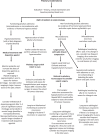Management of pituitary incidentalomas
- PMID: 36958836
- PMCID: PMC11046515
- DOI: 10.7861/clinmed.2023-0020
Management of pituitary incidentalomas
Abstract
Pituitary incidentalomas are common findings with increasing use of modern neuroradiological imaging undertaken for symptoms unrelated to pituitary disease. The prevalence of these lesions is ∼10% in autopsy studies and the incidence varies from 10% to 38% on magnetic resonance imaging in the published literature. They are almost always benign in nature and most are non-functioning (non-secreting) adenomas. Although many individuals are asymptomatic at diagnosis, some with functioning (secreting) pituitary adenomas or larger non-functioning adenomas have symptoms. All identified cases should have a thorough clinical and endocrinological evaluation to help with precise management, which depends on the size of the lesion, hormonal status (functioning versus non-functioning adenoma) and the presence of visual deficits resulting from optic nerve compression by the pituitary adenoma. Here, we provide an overview of the initial assessment and management of pituitary incidentalomas for clinicians not routinely involved in the management of pituitary disease.
Keywords: Pituitary incidentalomas; pituitary adenomas; pituitary lesions; pituitary tumours.
© Royal College of Physicians 2023. All rights reserved.
Figures


References
-
- Feldkamp J, Santen R, Harms E, et al. Incidentally discovered pituitary lesions: high frequency of macroadenomas and hormone-secreting adenomas - results of a prospective study. Clin Endocrinol (Oxf) 1999;51:109–113. - PubMed
-
- Arita K, Tominaga A, Sugiyama K, et al. Natural course of incidentally found nonfunctioning pituitary adenoma, with special reference to pituitary apoplexy during follow-up examination. J Neurosurg. 2006;104:884–891. - PubMed
-
- Sanno N, Oyama K, Tahara S, Teramoto A, Kato Y. A survey of pituitary incidentaloma in Japan. Eur J Endocrinol. 2003;149:123–127. - PubMed
-
- Day PF, Guitelman M, Artese R, et al. Retrospective multicentric study of pituitary incidentalomas. Pituitary. 2004;7:145–148. - PubMed
-
- Reincke M, Allolio B, Saeger W, Menzel J, Winkelmann W. The “incidentaloma” of the pituitary gland. Is neurosurgery required? JAMA. 1990;263:2772–2776. - PubMed
MeSH terms
LinkOut - more resources
Full Text Sources
Medical

